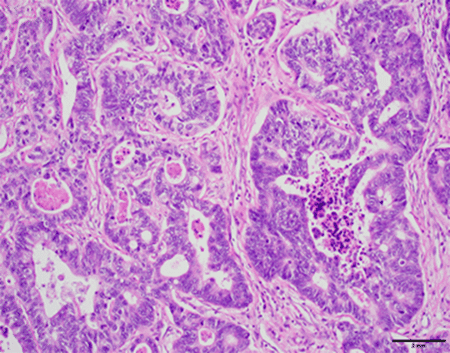Surveillance CT scan six months postsplenectomy revealed a 9 mm × 8 mm hypoenhancing lesion in the dome of the liver concerning for metastasis. Magnetic resonance imaging (MRI) confirmed a 1.3 cm × 1.2 cm T2 hyperintense lesion in the hepatic dome concerning for metastatic disease; she is currently undergoing further evaluation.
Discussion
Splenic tumors, both primary and metastatic, are a rare entity. Less than one percent of all metastases occur in the spleen,1 with the most common primaries arising from breast, lung, colorectal, or ovarian origin.2 Colorectal cancer metastasis to the spleen is highly unusual and is typically a precursor of disseminated disease.3
Splenic metastases may present with a rising CEA, incidentally on imaging or clinically. Studies have shown a CEA elevation in the majority (81 percent) of cases.4 CT or ultrasound imaging can identify well-circumscribed lesions in the spleen; FDG-PET can confirm hypermetabolism consistent with metastatic disease.5 Less commonly, clinical symptoms of splenomegaly with left upper quadrant pain or, more rarely, rupture may occur.
Despite the highly vascular nature of the spleen, metastases are incredibly rare. This is theoretically attributed to unique characteristics of the spleen, such as anatomic, histologic, and immunologic properties. Anatomically, there is a sharp angle at the origin of the splenic artery from the celiac axis.6 Histologically, splenic sinusoids rhythmically contract and relax. This physiologic pattern of circulation is hypothesized to inhibit tumor emboli implantation. Immunologically, the spleen is composed of a reticuloendothelial system with immune surveillance conferred immunoglobulins, opsonins, and monocytes.7
Splenic metastasis is theorized to occur via hematogenous routes rather than lymphatic spread. One series reported 70 percent of primary lesions in the left colon,8 supporting one hypothesis of retrograde hematogenous spread to the spleen via the inferior mesenteric vein.9 The spleen lacks afferent lymphatic vessels. Splenic lymphatic vessels may lead to subcapsular metastases; however, most splenic metastases occur in the parenchyma.9
Metastatic colorectal cancer may be treated with surgery, chemotherapy, and radiotherapy. Splenectomy is a favored treatment option for low-volume disease given a low complication rate and potential for improved survival in colorectal cancer, particularly when followed by adjuvant chemotherapy.4 Historically, laparoscopic techniques were controversial due to the risk of peritoneal dissemination. More recent studies have demonstrated no greater risk of tumor cell dissemination laparoscopically than by conventional methods.10
Conclusion
Isolated splenic metastases are rare presentations of colorectal cancer and are typically associated with disseminated disease.
Lessons Learned
Careful surveillance of patients with colorectal cancer increases the likelihood of early diagnosis and treatment of recurrences.
Authors
Miller-Ocuin JLa; Ashburn JHa; Zhou Yb; Waters GSa
Author Affiliations
- Department of Surgery, Wake Forest School of Medicine, Winston-Salem, NC 27157
- Department of Pathology, Wake Forest School of Medicine, Winston-Salem, NC 27157
Corresponding Author
Jennifer L. Miller-Ocuin, MD
Department of Surgery
Wake Forest School of Medicine
1 Medical Center Boulevard
Winston-Salem, NC 27157
Phone: (724) 681-2131
Disclosure Statement
The authors have no conflicts of interest to disclose.
Funding/Support
The authors have no financial relationships or in-kind support to disclose.
Received: October 10, 2019
Accepted for Publication: June 18, 2020
References
- Sauer J, Sobolewski K, Dommisch K. Splenic metastases--not a frequent problem, but an underestimate location of metastases: epidemiology and course. J Cancer Res Clin Oncol. 2009;135(5):667-671. doi:10.1007/s00432-008-0502-3
- Compérat E, Bardier-Dupas A, Camparo P, Capron F, Charlotte F. Splenic metastases: clinicopathologic presentation, differential diagnosis, and pathogenesis. Arch Pathol Lab Med. 2007;131(6):965-969. doi:10.5858/2007-131-965-SMCPDD
- Berge T. Splenic metastases. Frequencies and patterns. Acta Pathol Microbiol Scand A. 1974;82(4):499-506.
- Abdou J, Omor Y, Boutayeb S, Elkhannoussi B, Errihani H. Isolated splenic metastasis from colon cancer: case report. World J Gastroenterol. 2016;22(18):4610-4614. doi:10.3748/wjg.v22.i18.4610
- Gencosmanoglu R, Aker F, Kir G, Tozun N. Isolated metachronous splenic metastasis from synchronous colon cancer. World J Surg Oncol. 2006;4:42. Published 2006 Jul 6. doi:10.1186/1477-7819-4-42
- Skandalakis PN, Colborn GL, Skandalakis LJ, Richardson DD, Mitchell WE Jr, Skandalakis JE. The surgical anatomy of the spleen. Surg Clin North Am. 1993;73(4):747-768. doi:10.1016/s0039-6109(16)46083-4
- Eichner ER. Splenic function: normal, too much and too little. Am J Med. 1979;66(2):311-320. doi:10.1016/0002-9343(79)90554-0
- Abi Saad GS, Hussein M, El-Saghir NS, Termos S, Sharara AI, Shamseddine A. Isolated splenic metastasis from colorectal cancer. Int J Clin Oncol. 2011;16(4):306-313. doi:10.1007/s10147-010-0182-2
- Indudhara R, Vogt D, Levin HS, Church J. Isolated splenic metastases from colon cancer. South Med J. 1997;90(6):633-636. doi:10.1097/00007611-199706000-00010
- Jingli C, Rong C, Rubai X. Influence of colorectal laparoscopic surgery on dissemination and seeding of tumor cells. Surg Endosc. 2006;20(11):1759-1761. doi:10.1007/s00464-005-0694-4



